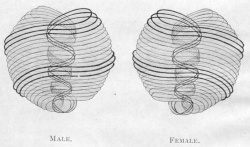Ultimate Physical Atom: Difference between revisions
Pablo Sender (talk | contribs) (Created page with "{{Template:Article needs expansion}} <br> <br> <br> right|250px|thumb|Ultimate physical atoms in its positive and negative forms == General appearance == The u...") |
Pablo Sender (talk | contribs) No edit summary |
||
| (One intermediate revision by the same user not shown) | |||
| Line 1: | Line 1: | ||
[[File:UPA.JPG|right|250px|thumb|Ultimate physical atoms in its positive and negative forms]] | [[File:UPA.JPG|right|250px|thumb|Ultimate physical atoms in its positive and negative forms]] | ||
== General appearance == | == General appearance == | ||
The ultimate physical atom was described as follows: | The ultimate physical atom was described as follows: | ||
Latest revision as of 16:45, 1 May 2014
General appearance
The ultimate physical atom was described as follows:
The ultimate atom, which is the same in all the observed cases, is an exceedingly complex body, and only its main characteristics are given in the diagram. It is composed entirely of spirals, the spiral being in its turn composed of spirillæ, and these again of minuter spirillæ. A fairly accurate drawing is given in Babbitt's "Principles of Light and Colour".[1]
The atom in reality is nearly globular, and its projecting points lie almost on the surface of a sphere. It looks somewhat like a wire cage, composed of ten endless wires, which lie completely separate and never touch one another--that is, if any one of them were taken out and uncoiled, and laid out flat, it would be a circle.[2]
Three of these ten wires are thicker than the rest, for in them the seven sets of spirillae do not fit accurately over one another (as they do in the other wires), because in every seven hundred turns there are four more atoms. This means an increase of one in every one hundred and seventy-five bubbles, and it is this which makes those three seem larger than the rest.[3]
The atom has three movements of its own: (1) rotation on its axis; (2) an orbital motion, for it is continually running round in a small circle; (3) a pulsation like a heart, a constant expansion and contraction. These three movements are always going on, and are unaffected by any force from outside.[4]
Forces
Turning to the force side of the atom and its combinations, we observe that force pours in the heart-shaped depression at the top of the atom, and issues from the point, and is changed in character by its passage; further, force rushes through every spiral and every spirilla, and the changing shades of colour that flash out from the rapidly revolving and vibrating atom depend on the several activities of the spirals; sometimes one, sometimes another, is thrown into more energetic action, and with the change of activity from one spiral to another the colour changes.[5]
The atom exists because of the force which the LOGOS is pouring through it, precisely as a little revolving column of dust and leaves, at the corner of the street, exists because of the whirling wind which made it. The existence of matter depends therefore absolutely upon the continuance of an idea in the mind of the LOGOS; if He chose to withdraw His force from the physical plane--to cease thinking it-- every physical atom would instantly disintegrate, and the whole physical plane would disappear in an instant like the light of a candle when it is blown out.
Besides this force which holds the atom together in its spiral form, a number of the forces of the LOGOS are also playing round its coils-- or perhaps we should rather say, one of His forces is playing at a number of different levels. There are seven orders of this force, which are eventually, at the end of the seventh round, to play fully round the seven sets of spirillae; but some of them are not yet in activity, since this is only the fourth round.[6]
See also
Online resources
Articles
- Atom at Theosopedia
Notes
- ↑ Annie Besant and Charles W. Leadbeater, Occult Chemistry, (London: Theosophical Publishing House, 1919), ???.
- ↑ Charles Webster Leadbeater, The Inner Life vol. II, (Wheaton, IL: Theosophical Press, 1942), 177.
- ↑ Charles Webster Leadbeater, The Inner Life vol. II, (Wheaton, IL: Theosophical Press, 1942), 178.
- ↑ Charles Webster Leadbeater, The Inner Life vol. II, (Wheaton, IL: Theosophical Press, 1942), 178.
- ↑ Annie Besant and Charles W. Leadbeater, Occult Chemistry, (London: Theosophical Publishing House, 1919), ???.
- ↑ Charles Webster Leadbeater, The Inner Life vol. II, (Wheaton, IL: Theosophical Press, 1942), 178-179.
